Basic Information
-
Targeting strategy

-
Gene targeting strategy for B-hTSLP/hTSLPR mice plus. The exons 1-5 of mouse Tslp gene that encode the full-length protein were replaced by human TSLP exons 1-4 in B-hTSLP/hTSLPR mice plus. The signal peptide, extracellular and transmembrane region of human TSLPR gene and the cytoplasmic region of mouse Tslpr gene were constructed into a chimeric CDS vector and inserted into the mouse exon 2. The targeted mice will express the chimeric TSLPR protein, while mouse TSLPR will no longer express in B-hTSLP/hTSLPR mice plus.
-
Protein expression analysis

-

Strain specific TSLP expression analysis in wild type C57BL/6 mice, homozygous B-hTSLP/hTSLPR mice and B-hTSLP/hTSLPR mice plus by ELISA. Calcipotriol (MC903) was dissolved in ethanol and topically applied on ears of wild type C57BL/6 mice, homozygous B-hTSLP/hTSLPR mice and B-hTSLP/hTSLPR mice plus for 7 days. Ear grinding supernatant from the three strain of mice were analyzed by ELISA. Mouse TSLP was only detectable in wild type C57BL/6 mice. Human TSLP was detectable in homozygous B-hTSLP/hTSLPR mice and B-hTSLP/hTSLPR mice plus but not in wild type mice.

Mouse and human TSLPR expression analysis in splenocytes. Splenocytes were collected from wild type C57BL/6 mice, homozygous B-hTSLP/hTSLPR mice and B-hTSLP/hTSLPR mice plus. TSLPR expressed on cDC, pDC and non DCs were analyzed by flow cytometry with species-specific anti-TSLPR antibody. Mouse TSLPR were detectable on cDC, pDC and non DCs of wild type C57BL/6 mice, but not on the cells of TSLPR humanized mice. Human TSLPR was detectable on cDC, pDC and non DCs of B-hTSLP/hTSLPR mice and B-hTSLP/hTSLPR mice plus, but not on the cells of wild type C57BL/6 mice.

Mouse and human TSLPR expression analysis in bone marrow. Bone marrow cells were collected from wild type C57BL/6 mice, homozygous B-hTSLP/hTSLPR mice and B-hTSLP/hTSLPR mice plus. TSLPR expressed on bone marrow cells were analyzed by flow cytometry with species-specific anti-TSLPR antibody. Mouse TSLPR were detectable on cDC, pDC and non DCs in wild type C57BL/6 mice, but not on the cells of TSLPR humanized mice. Human TSLPR was detectable on cDC, pDC and non DCs of B-hTSLP/hTSLPR mice and B-hTSLP/hTSLPR mice plus, but not on the cells of wild type C57BL/6 mice.
-
Protein expression analysis of hTSLPR in cDC1 from bone marrow

-

Human TSLPR expression analysis in cDC1 from bone marrow. Bone marrow were collected from wild type C57BL/6 mice, homozygous B-hTSLP/hTSLPR mice and B-hTSLP/hTSLPR mice plus. Human TSLPR expressed on cDC1 were analyzed by flow cytometry with species-specific antibodies. Human TSLPR was highly expressed on the cDC1 in B-hTSLP/hTSLPR mice and B-hTSLP/hTSLPR mice plus. Data from Huabo Biopharm Co. Ltd.
-
Analysis of leukocytes cell subpopulation in spleen

-

Analysis of spleen leukocyte subpopulations by flow cytometry. Splenocytes were isolated from female C57BL/6 and B-hTSLP/hTSLPR mice plus (n=3, 9-week-old). Flow cytometry analysis of the splenocytes was performed to assess leukocyte subpopulations. A. Representative FACS plots. Single live cells were gated for the CD45+ population and used for further analysis as indicated here. B. Results of FACS analysis. Percent of T cells, B cells, NK cells, DCs, neutrophils, monocytes and macrophages in homozygous B-hTSLP/hTSLPR mice plus were similar to those in the C57BL/6 mice, demonstrating that TSLP,TSLPR and IL7R humanized does not change the overall development, differentiation or distribution of these cell types in splenocytes. Values are expressed as mean ± SEM.
-
Analysis of T cell subpopulation in spleen

-

Analysis of spleen T cell subpopulations by flow cytometry. Splenocytes were isolated from female C57BL/6 and B-hTSLP/hTSLPR mice plus (n=3, 9-week-old). Flow cytometry analysis of the splenocytes was performed to assess leukocyte subpopulations. A. Representative FACS plots. Single live CD45+ cells were gated for CD3+ T cell population and used for further analysis as indicated here. B. Results of FACS analysis. The percent of CD4+ T cells, CD8+ T cells and Tregs in homozygous B-hTSLP/hTSLPR mice plus were similar to those in the C57BL/6 mice, demonstrating that TSLP,TSLPR and IL7R humanized does not change the overall development, differentiation or distribution of these T cell types in spleen. Values are expressed as mean ± SEM.
-
Analysis of leukocytes cell subpopulation in blood

-

Analysis of blood leukocyte subpopulations by flow cytometry. Blood were isolated from female C57BL/6 and B-hTSLP/hTSLPR mice plus (n=3, 9-week-old). Flow cytometry analysis of the blood was performed to assess leukocyte subpopulations. A. Representative FACS plots. Single live cells were gated for the CD45+ population and used for further analysis as indicated here. B. Results of FACS analysis. Percent of T cells, B cells, NK cells, dendritic cells, neutrophils, monocytes and macrophages in homozygous B-hTSLP/hTSLPR mice plus were similar to those in the C57BL/6 mice, demonstrating that TSLP,TSLPR and IL7R humanized does not change the overall development, differentiation or distribution of these cell types in blood. Values are expressed as mean ± SEM.
-
Analysis of T cell subpopulation in thymus

-
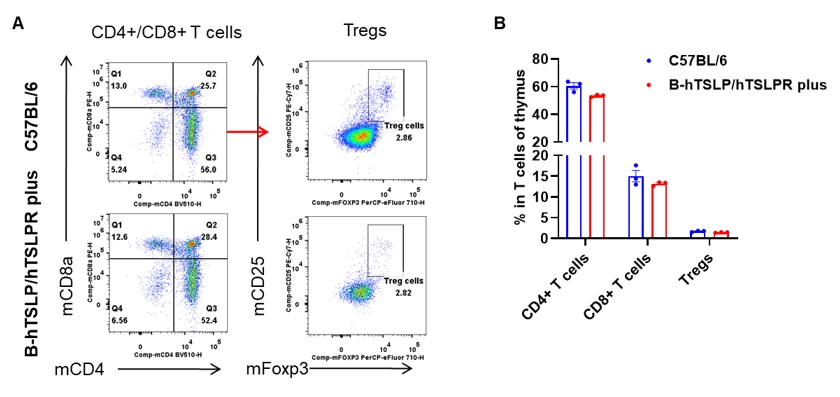
Analysis of thymus T cell subpopulations by flow cytometry. Thymuses were isolated from female C57BL/6 and B-hTSLP/hTSLPR mice plus (n=3, 9-week-old). Flow cytometry analysis of the thymus was performed to assess leukocyte subpopulations. A. Representative FACS plots. Single live CD45+ cells were gated for CD3+ T cell population and used for further analysis as indicated here. B. Results of FACS analysis. The percent of CD4+ T cells, CD8+ T cells and Tregs in homozygous B-hTSLP/hTSLPR mice plus were similar to those in the C57BL/6 mice, demonstrating that TSLP, TSLPR and IL7R humanized does not change the overall development, differentiation or distribution of these T cell types in thymus. Values are expressed as mean ± SEM.
-
Functional analysis

-
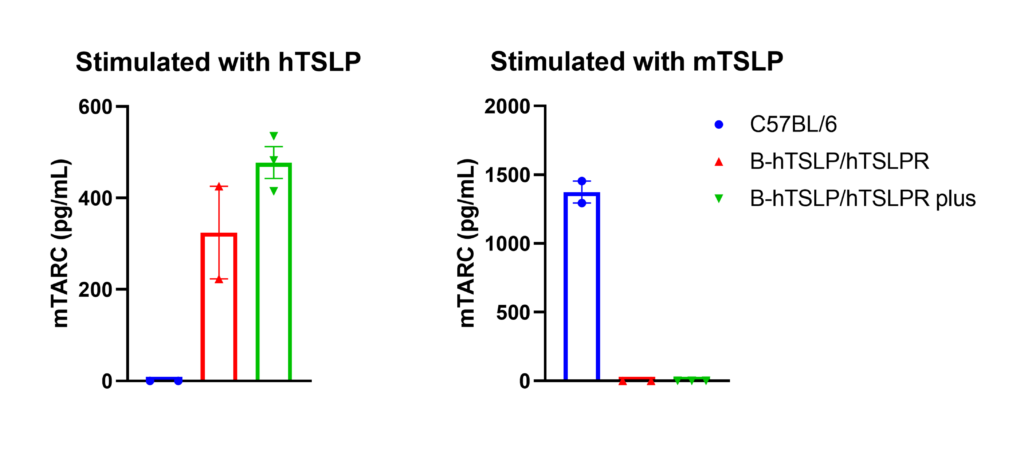
Mouse TARC was respectively induced with human TSLP and mouse TSLP in wild type C57BL/6 mice, homozygous B-hTSLP/hTSLPR mice and B-hTSLP/hTSLPR mice plus. Dendritic cells were respectively induced with FLT3L from bone marrow of the three strains and stimulated with human TSLP or mouse TSLP in vitro. Concentration of mouse TARC secreted from DCs was assayed by ELISA. Mouse TARC was successfully induced with human TSLP, but not mouse TSLP in homozygous B-hTSLP/hTSLPR mice and B-hTSLP/hTSLPR mice plus. The level of mTARC in B-hTSLP/hTSLPR mice plus was higher than that in B-hTSLP/hTSLPR mice plus. Meanwhile mouse TARC was successfully induced with mouse TSLP, but not human TSLP in wild-type C57BL/6 mice. Results indicated that TSLP and TSLPR are not cross-reactive between mouse and human. Human TSLP can activate the dendritic cells of B-hTSLP/hTSLPR mice and B-hTSLP/hTSLPR mice plus.
-
Growth curve

-
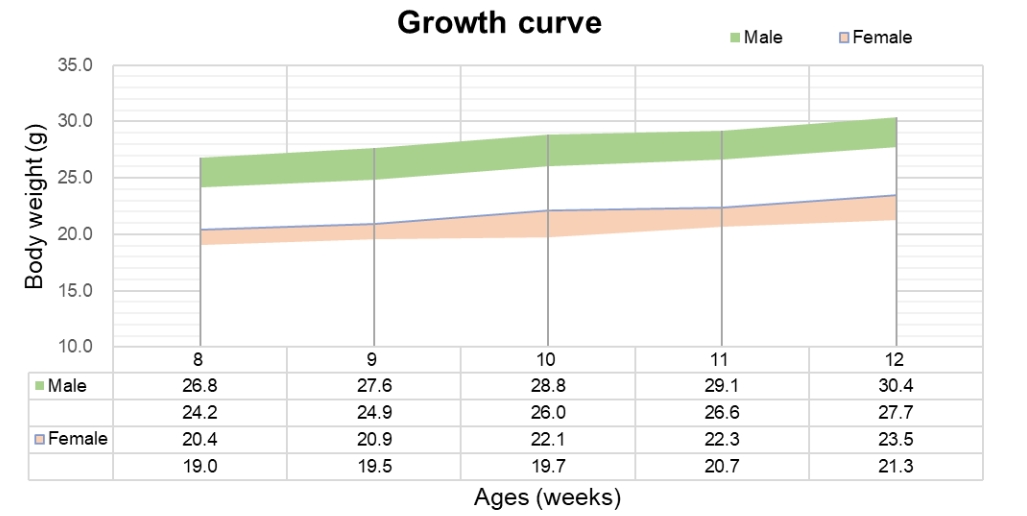
Growth curve of B-hTSLP/hTSLPR mice plus
Eight weeks old of mice were grouped (10 males and 10 females, respectively). Body weight was measured on the same day of every week and lasted for 12 weeks. The lowest and highest values of mouse body weight in the table were calculated from the mean ± SD. The growth curve conforms to the normal distribution and the probability of random error falling within ± SD is 68%.
-
Hematology analysis

-

Complete blood count (CBC) of B-hTSLP/hTSLPR mice plus. Values are expressed as mean ± SD.
-
Biochemistry analysis

-
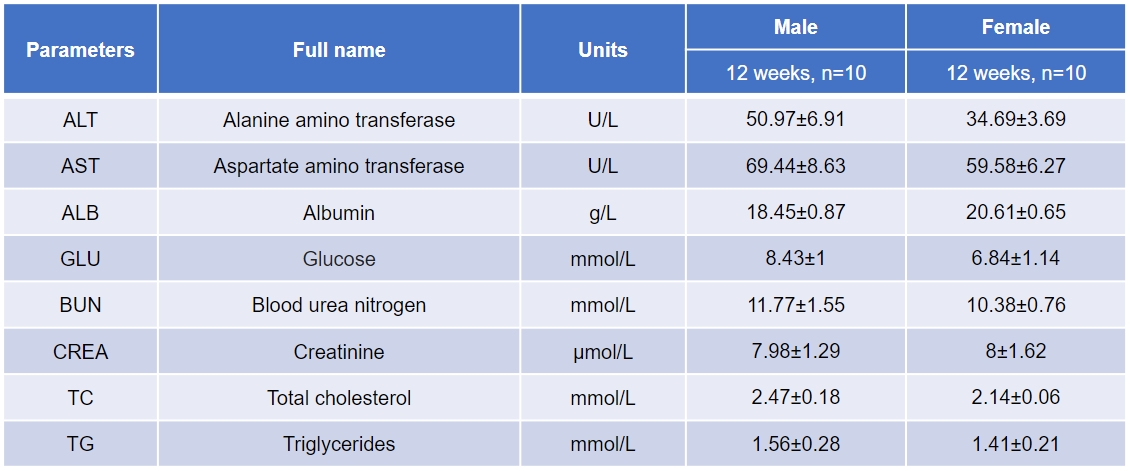
Blood biochemical test of B-hTSLP/hTSLPR mice plus. Values are expressed as mean ± SD.
-
Gross anatomy of female B-hTSLP/hTSLPR mice plus

-
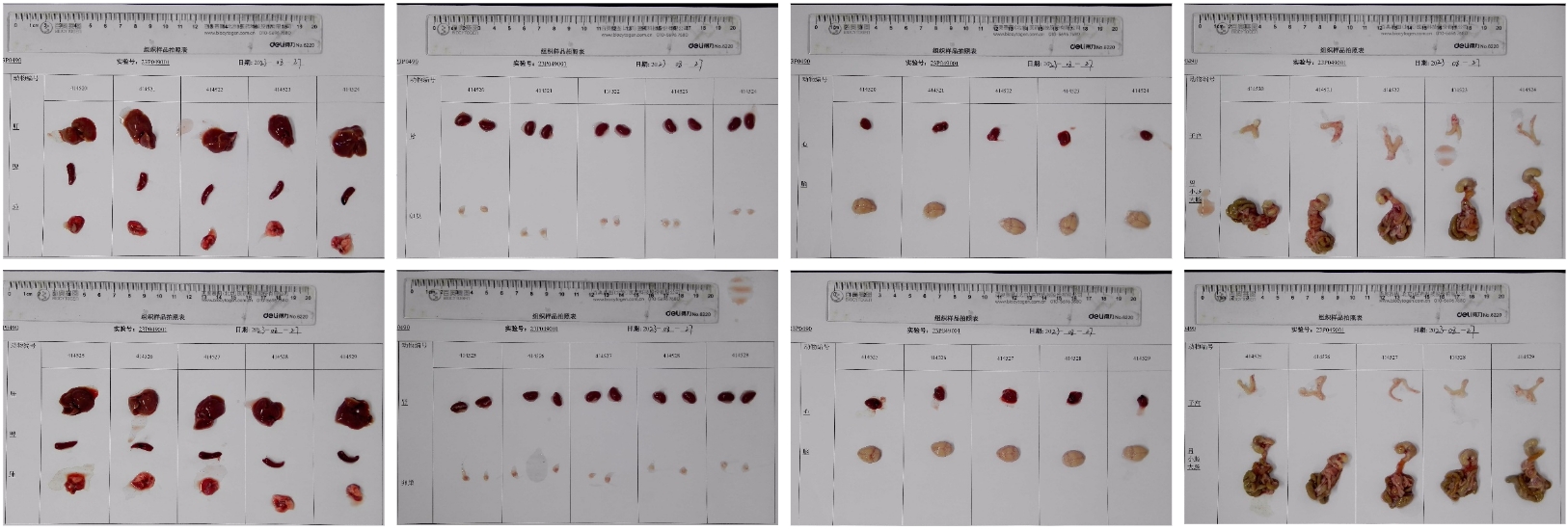
The organs of female B-hTSLP/hTSLPR mice plus (12-week-old, n=10).
-
Gross anatomy of male B-hTSLP/hTSLPR mice plus

-

The organs of male B-hTSLP/hTSLPR mice plus (12-week-old, n=10).
-
Organ weight

-
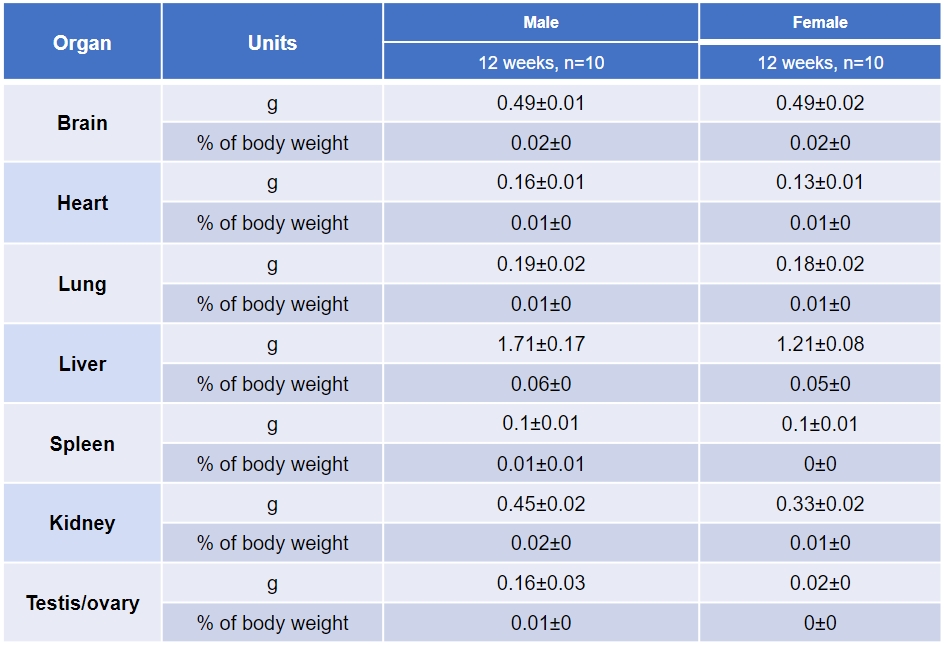
Average weight of the main organs of B-hTSLP/hTSLPR mice plus.
-
Histopathological analysis

-
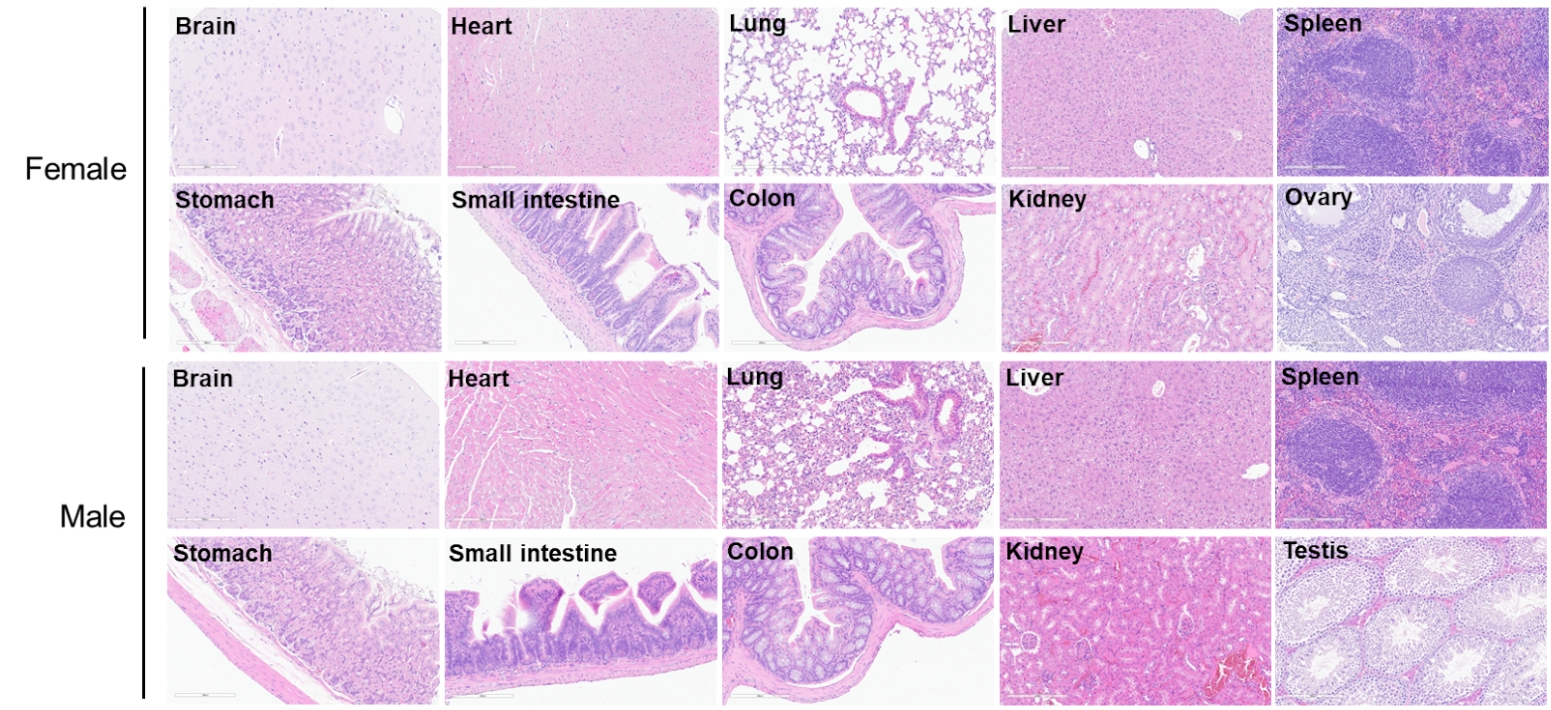
Histopathological analysis of organs in B-hTSLP/hTSLPR mice plus. The main organs of B-hTSLP/hTSLPR mice plus were isolated at 12 weeks of age and analyzed with H&E staining (male, n=10; female, n=10). Results showed that no obvious abnormalities were found in all of the organs (brain, heart, lung, liver, spleen, stomach, small intestine, colon, kidney, ovary, uterus and testis).
-
In vivo efficacy of anti-human TSLP antibody in a new mouse asthma model

-
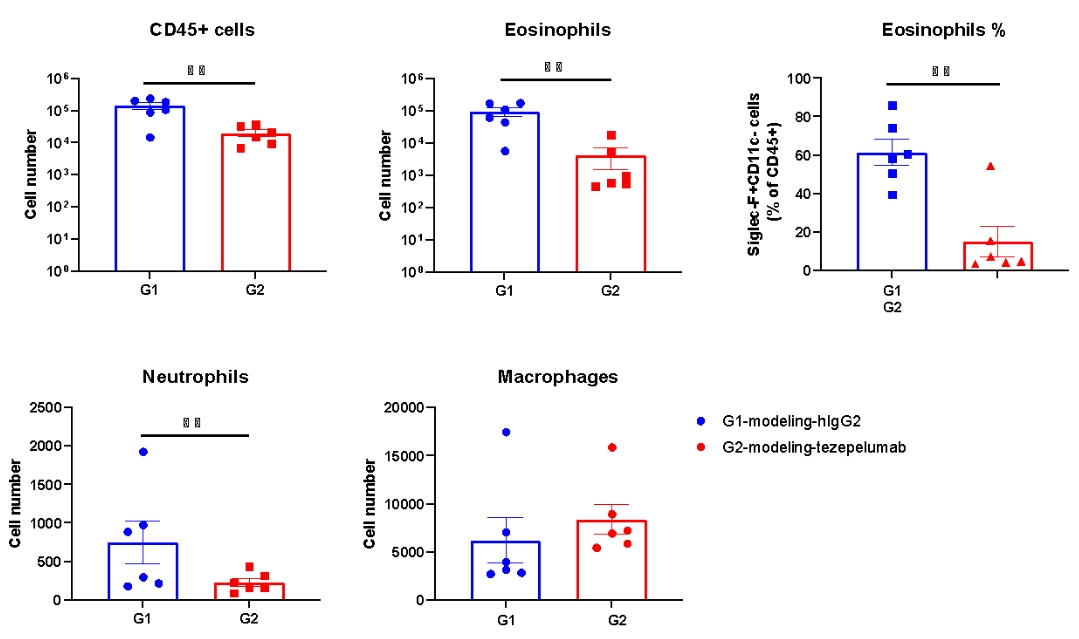
Analysis of inflammatory cells in BALF by FACS.
Mouse asthma model was induced in B-hTSLP/hTSLPR mice and treated with anti-human TSLP antibody (tezepelumab, synthesized in house). BALF was collected at the end of the experiment to detect infiltrated inflammatory cells in lung tissue. The results showed that CD45+ cells, eosinophils and neutrophils in the group (G2) treated with anti-human TSLP antibody decreased significantly when compared with the group (G1) treated with isotype antibody. Values are expressed as mean ± SEM.
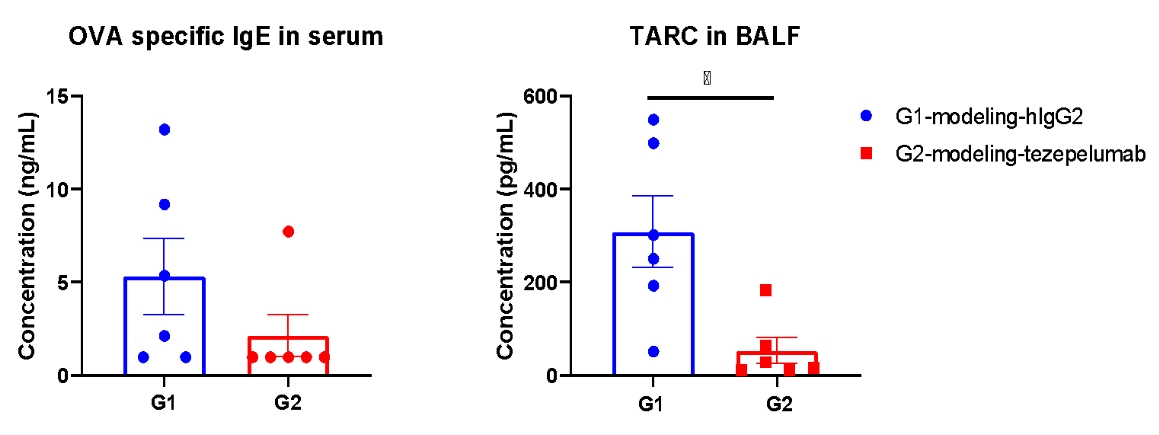
OVA specific IgE in serum and TARC in BALF were significantly reduced in the mouse asthma model treated with anti-TSLP antibody.
Serum was collected at the study endpoint. IgE and TARC levels were analyzed by ELISA. The results showed that the levels of OVA specific IgE and TARC in mice treated with tezepelumab (in house) was lower than that in untreated mice. Values are expressed as mean ± SEM. TARC: thymic and activating regulatory chemokine, also known as CCL17 (C-C motif chemokine ligand 17).

H&E staining of asthma-like model in B-hTSLP/hTSLPR mice plus
Lung tissues were collected at the study endpoint and analyzed with H&E staining. The results showed that compared to the untreated group (G1), the group of mice treated with tezepelumab (in house) showed a significant reduction in inflammatory infiltration and mucus secretion in lung tissue, indicating that B-hTSLP/hTSLPR mice provide a powerful preclinical model for in vivo evaluation of anti-human TSLP antibodies. Black arrow: inflammatory cells; black triangle: eosinophils; asterisk: mucus. Values are expressed as mean ± SEM.
-
Experimental schedule for Induction of AD-like skin lesions and in vivo efficacy of anti-human TSLP antibody

-

Experimental schedule for Induction of atopic dermatitis (AD)-like skin lesions and in vivo efficacy of anti-human TSLP antibody in B-hTSLP/hTSLPR mice plus. OXA was applied to ear skin of mice on day 0, and then challenge to the same site of skin nine times from days 7 to 25. Anti-human TSLP antibody tezepelumab (in house) was administered by intraperitoneal injection (n = 6). OXA: oxazolone.
-
In vivo efficacy of anti-human TSLP antibody in OXA induced AD-like mouse model

-
 Efficacy of anti-human TSLP antibody in B-hTSLP/hTSLPR mice plus. Mice in each group were treated with anti-hTSLP antibody tezepelumab (in house). (A) Statistical analysis of ear thickness in each group. Epidermis of ear began to desquamate from day 18. So the ear thicknesses were decreased from day 18 as shown in figure. (B) Body weight changes during the treatment. (C) Total IgE levels in serum. Serum was collected on day 26 and total IgE levels were measured by ELISA. (n = 6). Values are expressed as mean ± SEM.
Efficacy of anti-human TSLP antibody in B-hTSLP/hTSLPR mice plus. Mice in each group were treated with anti-hTSLP antibody tezepelumab (in house). (A) Statistical analysis of ear thickness in each group. Epidermis of ear began to desquamate from day 18. So the ear thicknesses were decreased from day 18 as shown in figure. (B) Body weight changes during the treatment. (C) Total IgE levels in serum. Serum was collected on day 26 and total IgE levels were measured by ELISA. (n = 6). Values are expressed as mean ± SEM. -
H&E staining of ear skin in AD-like mouse model of B-hTSLP/hTSLPR mice plus

-
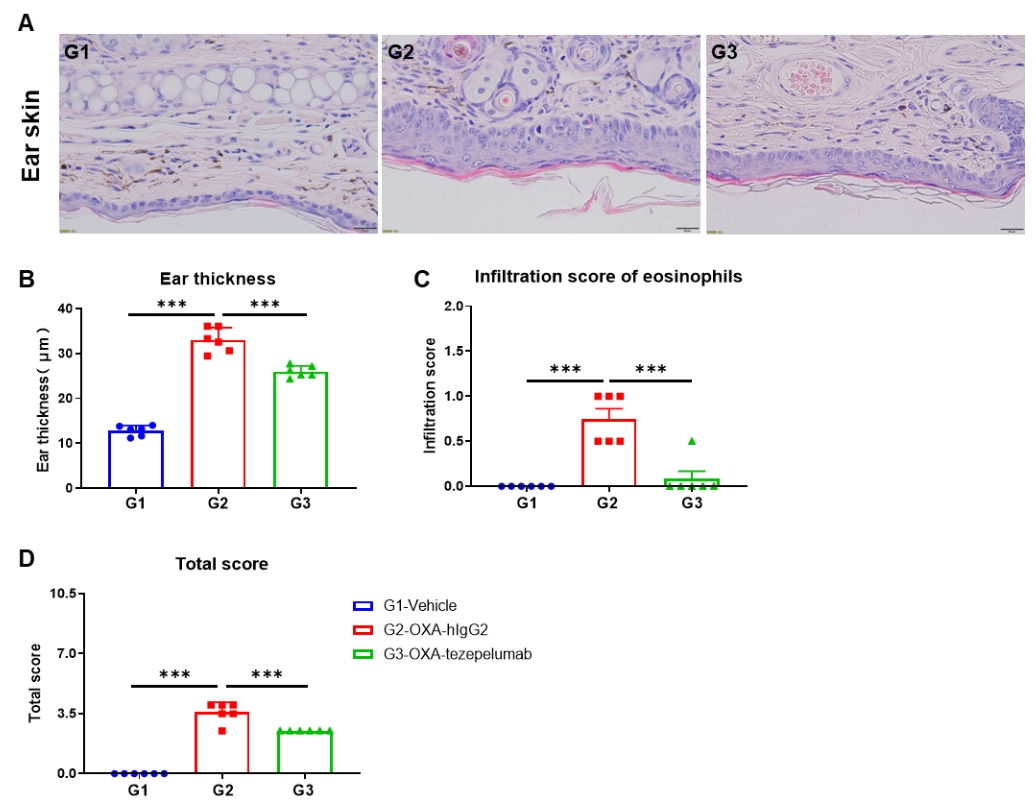
Effects of anti-human TSLP antibody on ear skin of the AD mouse model. (A) Hematoxylin and eosin (H&E) staining. (B) Thickness of ear epidermal skin. (C) Score of eosinophils infiltrated in ear epidermal skin. (D) Total score of ear epidermal skin. Ear thickness and infiltration scores of eosinophils in ear skin of the groups treated with Tezepelumab (in house) were decreased significantly compared to that in the isotype control, demonstrating that the B-hTSLP/hTSLPR mice plus provide a powerful preclinical model for in vivo evaluation of anti-human TSLP antibodies. Infiltration score of eosinophils: 1=slight; 2=mild; 3=moderate; 4=severe. The content of the pathology total score evaluation includes the following aspects: epidermal hyperplasia in skin, erosion/crusting, hyperkeratosis and parakeratosis; inflammatory cell infiltration in dermis and subcutaneous. AD: Atopic dermatitis.
-
Summary

-
Protein expression analysis:
- Mouse TSLP was only detectable in wild type C57BL/6 mice. Human TSLP was detectable in homozygous B-hTSLP/hTSLPR mice and B-hTSLP/hTSLPR mice plus but not in wild type mice.
- Mouse TSLPR was detectable on cDC, pDC and non DCs from spleen and bone marrow of wild type C57BL/6 mice.
- Human TSLPR was detectable on cDC, pDC and non DCs from spleen and bone marrow of B-hTSLP/hTSLPR mice and B-hTSLP/hTSLPR mice plus.
Leukocytes cell subpopulation analysis:
- TSLP and TSLPR humanized does not change the overall development, differentiation or distribution of immune cell types in spleen, blood, lymph nodes and thymus.
Functional analysis:
- TSLP and TSLPR are not cross-reactive between mouse and human.
- Human TSLP can only activate the dendritic cells of B-hTSLP/hTSLPR mice and B-hTSLP/hTSLPR mice plus. Mouse TSLP can only activate the dendritic cells of wild-type C57BL/6 mice.
Detection of various physiological indicators:
- The body weight, complete blood count and blood biochemical test of male and female B-hTSLP/hTSLPR mice plus were analyzed. The main organs were dissected, weighed and analyzed by H&E staining. No obvious abnormalities were found in all the organs detected (brain, heart, lung, liver, spleen, stomach, small intestine, colon, kidney, uterus, ovary and testis).
In vivo efficacy:
- OVA induced asthma model: Anti-human TSLP antibody was efficacious in reducing eosinophils and IgE induced by OVA in B-hTSLP/hTSLPR mice plus. H&E staining results showed a significantly reduction in eosinophils infiltration in mice treated with tezepelumab (in house).
- OXA induced AD model: Anti-human TSLP antibody was efficacious in reducing ear thickness in the AD model induced by OXA in B-hTSLP/hTSLPR mice plus.


